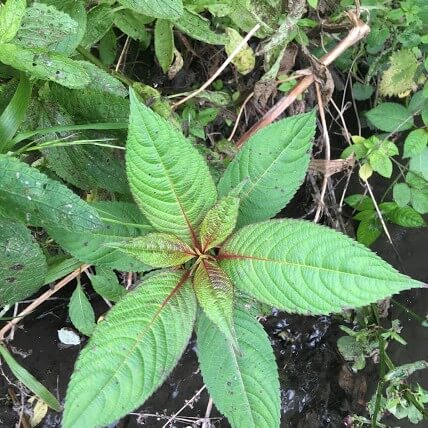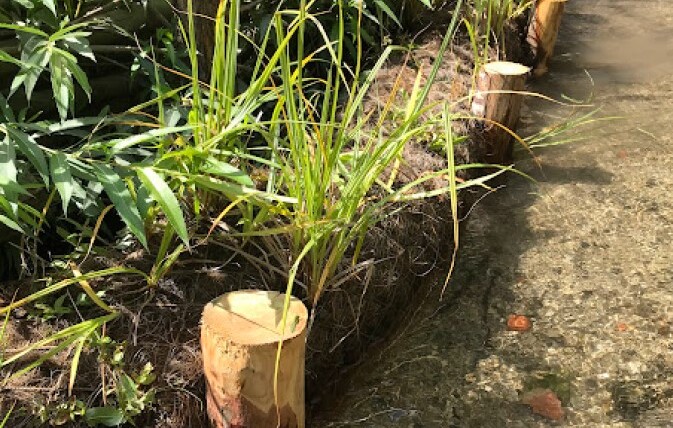Wildlife Highlights
I don’t need to tell you that 2020 has been a strange year but as far as the wildlife on Letcombe Brook goes, it seems to have been a pretty good year.
Water voles are still classed as Britain’s fastest declining mammal but seem to be doing OK on the brook. The population is surveyed every 3 years as part of BBOWT’s Water Vole Recovery Project and was due to be carried out this year but was cancelled, like many other things, due to Covid. I found time to get out though and do some ad-hoc surveying and the populations at Grove Green and Mary Green in Grove and Limborough Rd, Wantage seem to be doing well. I managed to get some photos and video which was posted on Facebook and received lots of positive reaction. The only downside was the amount of disturbance at Grove Green particularly with lots of dogs in the water. One adult vole was found dead with what looked like a clear dog bite.

Vole activity was also identified at Willow Grange and Willow Walk in Wantage, Mably Way, Grove Bridge and the area downstream of Grove towards Williams F1 as well as at East Hanney downstream of the iron bridge. There is still a notable lack of voles in the Letcombes but one was spotted just upstream of the BBOWT reserve so fingers crossed that 2021 might see them recolonise that BBOWT reserve where there is some great habitat for them. We continue to monitor the brook for mink and some footprints were found in East Hanney during October so we will continue to do so.
Otter
Following the sad death of a mature male otter on the road at Grove in late 2019, we were very excited to learn a new male had arrived on the patch by the start of 2020. We were even more excited in the spring to hear we had a female with 2 cubs using the brook, the first time we have been aware of cubs. Thanks to the riparian owner that alerted us to this fact and provided some wonderful video footage of the mother and cubs. By late 2020 the cubs seemed to be travelling solo and may well be driven from the territory by any resident male. During the year otter activity has been recorded along the full length of the brook and a few people have been lucky enough to get a brief glimpse with 3 sightings in the evening in the Wantage Mill/Betjeman Park stretch.

A few people have raised concerns about otters eating all the fish but this isn’t really an issue in a natural system like the Letcombe Brook. They will off course catch and eat some fish but also eat the signal crayfish, eggs, birds, frogs and anything else they can catch. Otters can be a problem in over stocked commercial fishing lakes as they act like honey pots and are easy fishing. Wild brown trout in a small brook are not an easy target. Otters are also territorial, on a small watercourse like the brook, that territory will be very large so any pressure they exert will be spread over a large area.
Birds

Kingfishers also seemed to have a good year with at least one brook raised by a pair in Grove. I believe nesting also took place in Letcombe and East Hanney. Good spots to watch for them include the Cressbeds at Letcombe Bassett, around the lake area at Letcombe Valley Reserve, Grove Green and the iron bridge at East Hanney. Having said that I do see them regularly along most of the brook but its always a quick glimpse! Please remember they are a fully protected bird and it’s illegal to disturb nesting activity. If you do become aware of a nest (situated in a burrow in the bank) please move immediately and carefully away from the area and notify me of its location. The little egret continues to put in appearances along the brook. They seem most active at Letcombe but are now being seen more in Grove and East Hanney.
Grey wagtail is a red list species due to their declining numbers but can also be seen all along the brook. Please keep an eye out for yellow wagtail, a similar species but a summer visitor, much rarer in this part of the country and I am keen to collect records of this species along the brook. Spotted flycatcher are another one to look out for – seen in Letcombe Valley and Willow Walk during 2020 but a rare bird these days.
Reptiles
Grass snake were seen at Letcombe Bassett, Grove Green and down near Wick Farm during 2020. They are great swimmers and can catch fish. Unfortunately, they are still killed as people mistake them for adders, our only poisonous snake. Adders are protected and should never be killed, not that you are likely to see one in Oxfordshire, there are concerns they are now lost to this County which is a great shame.
Common lizard is probably present more often than we realise. Sightings were made in Letcombe Bassett and Grove in the past year but they are another fast declining species. They have no special association to the brook, but the adjoining green corridor provided along its banks is important for many species.
Fish
Brown trout are present all the way along the brook but populations are impacted by the many obstructions present which prevent movement to better spawning areas, mixing of populations and movement away from low-flow areas or pollution. Modification or removal of these obstructions remains a major aim of LBP and the EA.
Other fish present include the bullhead, 3 and 9-spinned stickleback, minnow, gudgeon, roach and stone loach. It is hoped that as obstructions are removed and connectivity improved these populations will increase and be joined by chub, dace, perch and perhaps even the odd pike, eel or barbel. Not all stretches of Letcombe Brook are deep enough to support these species but the lower sections certainly are and could provide great spawning habitat for them on the clean gravels and rich water plants present.
Dragonflies and Damselflies
I have been excited to find both banded and beautiful demoiselle along the Letcombe Brook this year. Beautiful demoiselle are much more unusual but seem to be spreading. A few were seen in Wantage, Grove and Hanney and are worth looking out for next year. The males are very distinctive, the females much trickier! Please let us know if you see any!
Other species recorded on the Letcombe so far are:
Dragonflies- southern hawker, brown hawker, four-spot chaser, broad bodied chaser, emperor, common darter, ruddy darter.
Damselflies – azure, common blue, large red, blue-tailed, banded demoiselle, beautiful demoiselle

Invasive Species
Himalayan (Indian) Balsam -We continue to remove this along the brook as it’s an invasive non-native and can lead to erosion of the banks and reductions in native species. Please do remove any you find or let us know where it is if you are not able or willing. Many thanks to the Hanney volunteers for their many hours of hand-pulling balsam, it is paying dividends!

Mink – please let us know if you see a mink or any footprints with as exact location as possible. We are keen to eradicate mink from the Letcombe Brook so that water voles and birds can continue to recover. Field Studies Council (FSC) produce a great cheap guide to identifying mammal footprints, available online for about £4.
Signal Crayfish – these were first identified in the Wantage section of Letcombe Brook some years ago and the population in Wantage seems to be fairly high. Interestingly upstream and downstream seems to have much less signals, this would appear to indicate that this invasive species was introduced (accidentally or purposefully) to the brook at or near Wantage. No white-clawed (native) crayfish have been identified in the brook since approximately 2009 which is not a surprise. Once signal crayfish are present in a watercourse the native crayfish soon die out due to the crayfish plague carried by signals.
Other species
Bats The brook is an important feeding corridor for several bat species including common and soprano pipistrelle and daubenton’s bat. No doubt other species such as brown long-eared, noctule and serotine are also present at times. The high levels of insects emerging from or attracted to the brook are an important food source and some of the larger trees along the brook act as roost sites. Good places to watch bats include the BBOWT reserve at Letcombe, Betjeman Park area and Willow Walk in Wantage and the iron bridge in East Hanney. It’s even more fun listening to them with a bat detector!
Water shrew are present on the brook but a very overlooked species and easily missed due to their small size. Do let me know if you spot one. They are very distinctive compared to other shrews with black fur and a silver-grey underside. The picture is of a dead one I found at Willow Walk in Wantage. Predators catch them but often do not eat them as they secrete a foul -smelling liquid from their glands.

Volunteering Activities
Activities have been heavily impacted by Covid and fewer work parties took place this year for that reason. Riverfly monitoring was also reduced and no events were held since the Volunteer thank you event in February. We did manage to hold some work parties including habitat improvement work at Letcombe (Millennium Green), Wantage (Limborough Rd and Willow Walk) Grove (Grove Green, Mably Way, Kingfishers) and East Hanney (Poughley Farm).
Many thanks to the youngsters that are continuing with river wardening surveys as part of their Duke of Edinburgh Award Scheme activities.
Funded Projects
LBP were successful in securing funding from the Environment Agency’s WEIF funds for 2 projects. Funding paid for the Lower Mill Fish Pass which has now been completed and improves fish passage along the Letcombe Brook as well as creating some excellent habitat.
Funding for the “Love the Letcombe Project” has enabled us to carry out habitat improvement works at several sections along the brook. We have focused on pollarding bankside trees to allow more light to reach the brook and its banks which will encourage riparian habitat recovery which will in turn support water vole, brown trout and aquatic invertebrate populations.
Fundraising
In what has been a tough year LBP have managed to secure some additional funding which is great news. Aside from the EA funding mentioned above, Lesley has been able to secure funds from several private Trusts. This money can be used for additional project work and to purchase equipment for our volunteers. We also secured Section 106 funding for interpretation at Letcombe Regis and Councillor Priority Funding for improvement work at Willow Walk in Wantage.
Looking Ahead
We will endeavour to return to normal volunteering activities as soon as it’s safe to do so. In the meantime, if you are kicking your heels the brook corridor makes a great place to take your exercise walk. Keep an eye out for wildlife and do let us know if you see anything exciting You can help us demonstrate the importance of Letcombe Brook as a wildlife corridor by reporting your wildlife sightings using the iRecord app – its free to download to your smartphone and easy to use.
Please do let us know if you spot a potential problem or something that concerns you such as dead fish or an obstruction in the brook that could cause a flood risk. If you would like to help with some litter picking during your exercise walks do let me know and I can provide you with some equipment.
2021 may prove to be a tricky year for event but if we get on top of Covid we will try and put on some small-scale events such as guided walks, river dipping or bat walks. We will be supporting BBOWT’s Wildlife Discovery day at Letcombe in July if it gets the go-ahead. Keep an eye on the Letcombe Brook Facebook Page, follow us on Twitter and keep an eye on the website for updates.
We will carry on with further tree work as part of the Love the Letcombe Project and hope to be able to get volunteers involved with that later in the year. We will also be carrying out further feasibility studies as part of this funding to assess removal or modification of other obstructions to fish passage.
We hope to take part in the next WaterBlitz survey organised by EarthWatch as we are keen to keep an eye on water quality in the Letcombe Brook and its tributaries.
You can be sure we are still working as hard as we can to look after our fabulous chalkstream. Keep in touch, be safe and enjoy the fabulous community green space provided along the brook!
All the best,
Mark Bradfield, Project Officer




